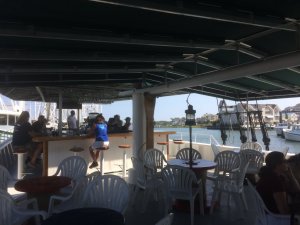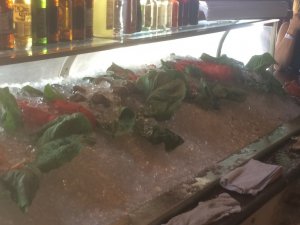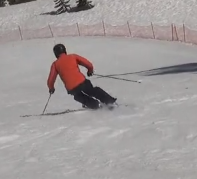....These are just some late spring turns at Squaw Valley. Shirley Lake Race area. (4th chute)
....shmedium to Short radius turns.
....Remember, the goal here is to try to look at ski snow interaction, Ski performance, body performance. and try to leave out any corrective opinions. By learning how to do MA by breaking down actual movements, how the five fundamentals are being applied, etc, It really allows the observer to figure out what the cause is and then how they might affect an change/outcome......
I see consistent shortish radius turns in what looks like dense, settled spring glop that used to be bumps.
The blue pitch (?) gives skier some speed.
Skis are not sinking deep into the snow, but they are embedded in it, not floating on top. Guessing Head Titan, shortish turn radius, waist 80?
General turn radius is being heavily influenced by the bend in the ski, although some muscular rotation is happening at the top of the turns.
In a few turns the skis are moving diagonally across the snow (ex: 0.13-0.15), in others they are slicing through it with tails following tips.
Skier's head is up and he is looking where he is going.
Stance width is narrowish and stays constant during the whole run.
Tip lead is minimal.
Snow spray in the frame below indicates the both skis are engaged. The spray comes off the fronts as well as the backs of the skis, indicating skier is centered. This snow spray pattern appears to be fairly consistent throughout the run, indicating the skier is keeping impactful weight on the inside ski. Depending on the snow, this weight distribution may be helping with what float there is.
I'd like to see a side view taken by a videographer moving alongside the skier. This is needed to determine if the skier is moving fore-aft along the skis through each turn. Only a profile shot offers certainty. My first guess is that the skier is working to stay centered fore-aft through the turns.
But in the shots below, the only side-ish views in the video, the skier's ankles appear to be open. Spine tilt does not match shin tilt. Perhaps the skier is moving the skis ahead to load the tails here at turn's end, in order to get them to grip. Not enough side-views to see if he is doing this consistently or not.
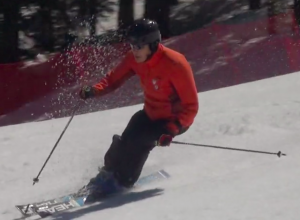
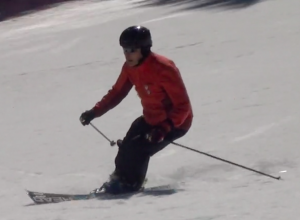
Skier releases old turns and initiates new ones by lengthening and shortening each leg simultaneously. As a result, his body moves up and down a bit with each turn. He also tips the new inside ski to its little toe edge ahead of the outside ski, as in the frame below. This makes him look bowlegged momentarily, and functionally keeps his skis parallel during initiation. He also rotates the skis around in the top half of the turns, using femur rotation. This gives the top of his turns a tighter radius than the bottoms.
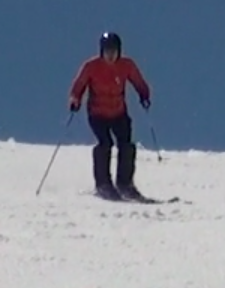
Maximum underfoot pressure happens a bit after fall line, about here in the frame below. In some turns the skis slide out a bit as the skier sinks lower and this pressure maxes out. Frame below 0:11.
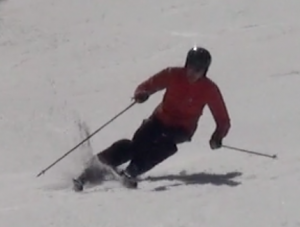
After this "pulse" the skier quickly initiates the next turn.
Pulse, release, pulse, release. This change from old turn (with body low and maximum underfoot pressure) to body moving up (with skis lightened) is quickly executed.
Skier's upper body stays quiet. He is limber enough at the hip sockets to bend forward there, and to rotate his femurs there. The spine stays stable without twisting or bending down and straightening up. His angulation directs pressure to the outside ski, but not totally.
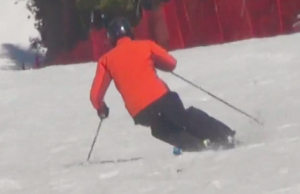
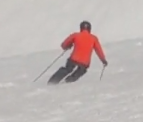
There's a whoopsie at 0.19. Looks like one of the skis hit something. Does not appear to be caused by skier imbalance. Followed by quick recovery.
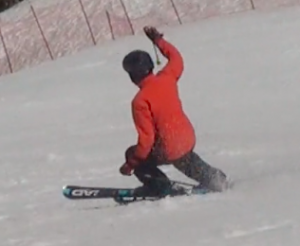
Hand-arm-pole management is consistent, excluding the one frame above. Elbows are out, hands stay out and a bit below elbows. Right hand flicks pole basket ahead to plant it in front of toe piece, left hand does not do this and consequently basket taps snow behind foot. I see no unfavorable consequences in ski-snow interaction from this lack of symmetry in this run. If this is an habitual pattern, this asymmetry impact other turns on different terrain and in different conditions.
I don't look at turns through the filter the PSIA five fundamentals provide. I prefer to do what I just did. I would use that filter for MA in a certification exam, however, since that's what they want.







